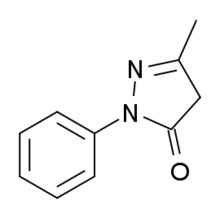Edaravone
 | |
|---|---|
| Systematic (IUPAC) name | |
| 5-methyl-2-phenyl-2,4-dihydro-3H-pyrazol-3-one | |
| Clinical data | |
| Legal status | ℞ Prescription only |
| Routes | Oral |
| Identifiers | |
| CAS number | 89-25-8 |
| ATC code | None |
| PubChem | CID 4021 |
| ChemSpider | 3881 |
| UNII | S798V6YJRP |
| KEGG | D01552 |
| ChEBI | CHEBI:31530 |
| ChEMBL | CHEMBL290916 |
| Synonyms | MCI-186 |
| Chemical data | |
| Formula | C10H10N2O |
| Mol. mass | 174.20 g/mol |
| SMILES
| |
| |
| | |
Edaravone (Radicut) is a neuroprotective agent used for the purpose of aiding neurological recovery following acute brain ischemia and subsequent cerebral infarction.[1] It acts as a potent antioxidant and strongly scavenges free radicals, protecting against oxidative stress and neuronal apoptosis.[2][3][4] It has been marketed solely in Japan by Mitsubishi Pharma since 2001.[1] and marketed in India by Edinburgh Pharmaceuticals by the brand name Arone
Edaravone has been shown to attenuate methamphetamine- and 6-OHDA-induced dopaminergic neurotoxicity in the striatum and substantia nigra, and does not affect methamphetamine-induced dopamine release or hyperthermia.[5][6] It has also been demonstrated to protect against MPTP-mediated dopaminergic neurotoxicity to the substantia nigra, though notably not to the striatum.[7][8][9]
References
- ↑ 1.0 1.1 Doherty, Annette M. (2002). Annual Reports in Medicinal Chemistry, Volume 37 (Annual Reports in Medicinal Chemistry). Boston: Academic Press. ISBN 0-12-040537-7.
- ↑ Watanabe T, Tanaka M, Watanabe K, Takamatsu Y, Tobe A (March 2004). "[Research and development of the free radical scavenger edaravone as a neuroprotectant]". Yakugaku Zasshi (in Japanese) 124 (3): 99–111. PMID 15049127.
- ↑ Higashi Y, Jitsuiki D, Chayama K, Yoshizumi M (January 2006). "Edaravone (3-methyl-1-phenyl-2-pyrazolin-5-one), a novel free radical scavenger, for treatment of cardiovascular diseases". Recent Patents on Cardiovascular Drug Discovery 1 (1): 85–93. PMID 18221078.
- ↑ Yoshida H, Yanai H, Namiki Y, Fukatsu-Sasaki K, Furutani N, Tada N (2006). "Neuroprotective effects of edaravone: a novel free radical scavenger in cerebrovascular injury". CNS Drug Reviews 12 (1): 9–20. doi:10.1111/j.1527-3458.2006.00009.x. PMID 16834755.
- ↑ Yuan WJ, Yasuhara T, Shingo T, et al. (2008). "Neuroprotective effects of edaravone-administration on 6-OHDA-treated dopaminergic neurons". BMC Neuroscience 9: 75. doi:10.1186/1471-2202-9-75. PMC 2533664. PMID 18671880.
- ↑ Kawasaki T, Ishihara K, Ago Y, et al. (August 2006). "Protective effect of the radical scavenger edaravone against methamphetamine-induced dopaminergic neurotoxicity in mouse striatum". European Journal of Pharmacology 542 (1-3): 92–9. doi:10.1016/j.ejphar.2006.05.012. PMID 16784740.
- ↑ Kawasaki T, Ishihara K, Ago Y, Baba A, Matsuda T (July 2007). "Edaravone (3-methyl-1-phenyl-2-pyrazolin-5-one), a radical scavenger, prevents 1-methyl-4-phenyl-1,2,3,6-tetrahydropyridine-induced neurotoxicity in the substantia nigra but not the striatum". The Journal of Pharmacology and Experimental Therapeutics 322 (1): 274–81. doi:10.1124/jpet.106.119206. PMID 17429058.
- ↑ Yokoyama H, Takagi S, Watanabe Y, Kato H, Araki T (June 2008). "Role of reactive nitrogen and reactive oxygen species against MPTP neurotoxicity in mice". Journal of Neural Transmission (Vienna, Austria : 1996) 115 (6): 831–42. doi:10.1007/s00702-008-0019-6. PMID 18235988.
- ↑ Yokoyama H, Yano R, Aoki E, Kato H, Araki T (September 2008). "Comparative pharmacological study of free radical scavenger, nitric oxide synthase inhibitor, nitric oxide synthase activator and cyclooxygenase inhibitor against MPTP neurotoxicity in mice". Metabolic Brain Disease 23 (3): 335–49. doi:10.1007/s11011-008-9096-3. PMID 18648914.
| |||||||||||